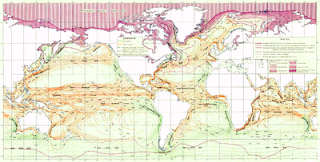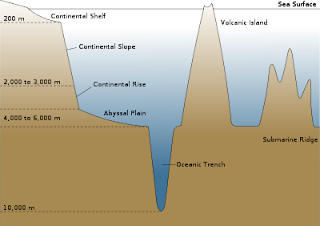
Marine life is plentiful along shores and in tidal pools, where the sun penetrates to the floor and the fluctuating tide continually circulates resources. This beach is along the shore of the Pacific Ocean, at the Point of Arches in the Olympic National Park in the state of Washington.
Tide pools are rocky pools by oceans that are filled with seawater. Tide pools are habitats of uniquely adaptable animals that have engaged the special attention of naturalists and marine biologists, as well as philosophical essayists: John Steinbeck wrote in The Log from the Sea of Cortez, "It is advisable to look from the tide pool to the stars and then back to the tide pool again
Tide pool zones, from shallow to deep

Tide pools provide a home for hardy organisms. Inhabitants must be able to cope with a constantly changing environment — fluctuations in water temperature, salinity, and oxygen content. Huge waves, strong currents, exposure to midday sun and predators are only few hazards that tide pools animals should endure to survive.
Waves can dislodge mussels and draw them out to sea. Gulls pick up and drop sea urchins to break them open. Starfishs prey on mussels and are eaten by gulls themselves. Even large predators as black bears sometimes feast on tide pool creatures at low tide. Although tide pool organisms must struggle to avoid getting washed away into the ocean, drying up in the sun, or getting eaten, they depend on the tide pool's constant changes for food.
 Tide pool flora
Tide pool flora
Sea anemone, Anthopleura elegantissima clone to reproduce. The process is called longitudinal fission. Few hours (or days) later after longitudinal fission has begun instead of one sea anemone there will be two. Sea anemones, Anthopleura sola are often seen to fight a war for territory. The white tentacles are fighting tentacles called acrorhagi. The acrorhagi contain stinging cells. The fighting sea anemones will continue to sting each other over and over again. After war ends one of them usually moves.
Tidal pool fauna Low tide zone
Low tide zoneThis subregion is mostly submerged — it is only exposed at the point of low tide and for a longer period during extremely low tides. This area is teeming with life; the most notable difference of this subregion compared to the other three is that there is much more marine vegetation, especially seaweeds. There is also a great biodiversity. Organisms in this zone generally are not well adapted to periods of dryness and temperature extremes. Some of the organisms in the low tide zone area are abalone, anemones, brown seaweed, chitons, crabs, green algae, hydroids, isopods, limpets, mussels, nudibranchs, sculpin, sea cucumber, sea lettuce, sea palms, sea stars, sea urchins, shrimp, snails, sponges, surf grass, tube worms, and whelks.
 Spray/splash zone
Spray/splash zone
This zone gets spray during high tides and water during storms. At other times the rocks bake in the sun or are exposed to cold winds. Only few organisms can survive such harsh conditions. Lichens and barnacles live in this region. In this zone, different species of barnacle live in very tightly constrained locations, allowing the exact height of an assemblage above or below sea level to be precisely determined.
Since the intertidal zone periodically desiccates, barnacles are well adapted against water loss. Their calcite shells are impermeable, and they possess two plates which they can slide across their aperture when not feeding. These plates also protect against predation.
 High and mid tide zone
High and mid tide zone
The high tide zone is flooded for few hours every day during each high tide. The organisms there must survive wave action, currents, and exposure to the sun. The high tide zone is inhabited by sea anemones, starfishes, chitons, crabs, green algae, and mussels. Marine algae can provide shelter for such organisms as nudibranchs and hermit crabs. The same waves and currents that make the life in the high tide zone so difficult bring in food to the filter feeders and other tide pool animals.
























